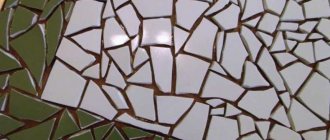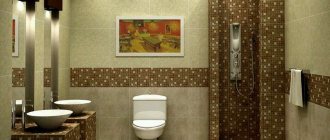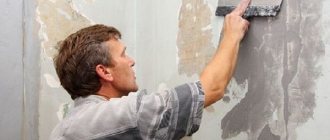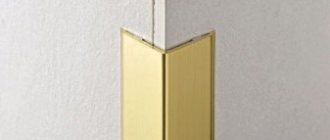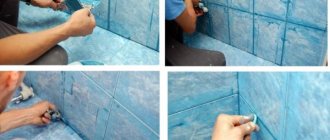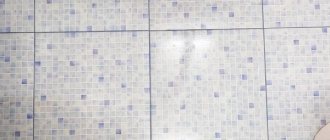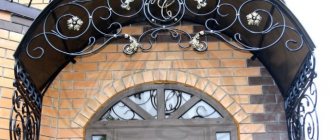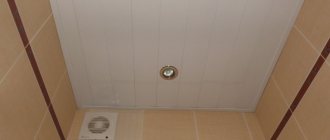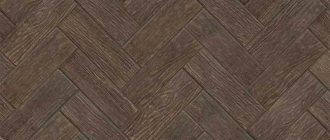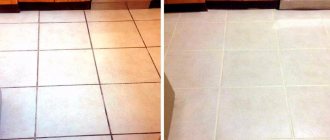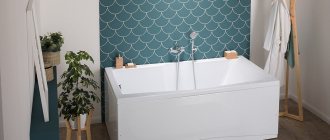The decorative panel under the bathtub gives the bathroom a finished look. To decorate it, you can choose a plastic or acrylic design. However, they will cost a lot, especially if the bowl has a non-standard shape.
It will be cheaper to build this screen yourself from tiles, which are glued onto a specially prepared frame. In addition to financial benefits, this decor option will fit perfectly into the interior of the room - they try to choose ceramic finishes in accordance with the walls and floor.
Let's figure out how to make a screen for a bathtub - we'll describe the methods of arranging the base for tiles and the technology of facing work. We have supplemented the information with visual photo instructions and videos that will help you carry out all the finishing processes yourself.
Why make a screen under the bathroom?
The walls and floor in the bathroom are tiled, and the plumbing is installed in its place and connected to communications. Everything looks great. The only problem that spoils the view is the space under the bathtub from its side down.
In order for the interior of the room to look harmonious and complete, it is necessary to somehow close the bathhouse itself and the pipes connected to it.
The main purpose of the decorative screen under the bathtub is to hide the unpresentable-looking legs and outer side of the bathtub from the eyes of the owners
If the bathing plumbing is made of acrylic or plastic, then in most cases it looks quite decent from the outside. On the contrary, cast iron or steel products do not please the eye. They must be decorated from the outside, otherwise the bathroom will not look too neat.
Housewives often store detergents and other household essentials under the bathroom. It is advisable to cover all this, as well as communications, with a decorative screen.
A screen like this is a great way to hide what is unnecessary and not too beautiful to look at. All these jars, bottles, rags and pipelines will be securely hidden behind it from people’s view.
If the bathroom is tiled, then it is recommended to make the screen under the bathtub from it as well. This way the design of this room can be decorated in a single, complete style.
The main thing when installing this decor is not to forget about the need to have access to communications. You will need to make a hatch in the screen, through which in case of leaks you can get to the pipes for repair.
How to choose the right glue
You can make adhesive for bathroom tiles yourself, or you can buy it. It all depends on the type of base, the amount of work and the skill of the finisher.
So, if you need to level out significant differences in height on the surface of the walls with glue, it is cheaper to do it at home. You will need: Portland cement, river sand (quarry sand must be sifted to remove small pebbles), PVA glue (can be replaced with dishwashing detergent, liquid soap or washing powder) and water.
The quality of such glue depends entirely on compliance with the proportions of the ingredients in the composition: 4 parts of sand are added to Portland cement grade 300, 400 - 5, 500 - 6 and 5-10% PVA glue diluted with water (1 part water, 2 parts glue) for every 10 kg mixtures.
For information: to improve the frost, heat and moisture resistance of homemade glue, resistance to chemicals, plasticity and adhesion, special additives are added to the solution: MasterTherm, superplasticizer - C3, liquid glass, dibutyl phthalate, resin additive DEG1, superplasticizer D5, etc. .
The method of use of each additive is described in the instructions for its use.
Ready-made types of tile adhesive come in the form of:
- dry mixtures - the composition contains all the necessary components. All that remains is to stir according to the instructions;
Dry tile adhesive.
- mastic - ready-to-use paste;
Mastic.
- adhesive solution (another name is “liquid nails”) - used only for repairing (replacing) tiles.
How to choose adhesive for bathroom tiles if you have to buy it?
Here the choice of glue is determined by the base on which the ceramics will be glued. Thus, universal cement and two-component epoxy adhesives adhere best to gypsum and cement plaster. For a plasterboard wall, you need a dispersion adhesive that has good adhesion, but does not penetrate deeply into the base.
The best brands to buy: Litokol, Knauf, Vetonit Ultra fix, Ceresit and Unis Plus.
Possible design options
Bathtubs vary in shape, material and functionality. But the methods of decorating the space underneath them using tiles are the same in all cases. It is necessary to make a reliable base for the tile, and then glue it according to all the rules and rub the seams.
When installing a decorative partition, you must remember the need for a niche for the feet, and also do not forget about the hatch, which facilitates access to sewer pipes
Structurally, screens under the bathroom can be:
- with hinged or sliding doors;
- removable or permanent;
- with retractable drawers, designs with or without shelves;
- deaf and with a niche at the bottom for feet.
The easiest way to lay tiles is under the side of the bathtub. When using it, you do not have to waste effort on carefully aligning the new edge.
It is enough to lay the top row of tiles under the side of the bathhouse or vertically flush with it. An additional plus is that the frame and rough surface for gluing ceramics in this case will also be easier to make.
If you decide to use ceramic tiles to line a niche under the bathroom, then the easiest way is to make a blank solid screen out of it without any frills. However, in case of blockages and leaks, it will not allow access to communications. It will need to be torn down and then re-decorated. It’s difficult to call such a decision thoughtful.
A blank tiled screen is easy to install and looks elegant, but if the bathtub siphon gets clogged or the pipes under it burst, then this decor will have to be destroyed without the possibility of restoration
A more practical option is with an inspection door or window. When installing such a screen, a technological hole is provided, closed with a plastic hatch or a removable panel the size of one tile. It turns out both presentable and practical.
Screens with sliding or swinging doors made of tiles are extremely difficult to make. The tile must be glued to a strong and undistorted base. But in the case of openable and closed door leaves, this is impossible to achieve. The tile will inevitably fall off from such a surface.
The bathtub is often used for bathing babies and washing clothes. At the same time, you have to stand close to her. If there is no niche made near the floor or the screen does not have a downward slope downwards from the edge of the bowl, then there will be nowhere to put your feet in this situation.
Standing nearby, you will have to bend deeper, unnecessarily straining your back. When decorating a bathtub, be sure to provide a recess for the feet.
Choosing ceramics for a bathtub panel
Ceramic tiles with glaze are impervious to moisture and durable. It is easy to maintain and install. Its only drawback is the fragility of the glazed layer; it easily cracks when struck. But if you don’t throw heavy objects at the tiles, then this problem is not so relevant and significant.
The markings on the box allow you to quickly navigate the assortment of ceramic tiles; for a screen in the bathroom, a cheap wall-mounted one that is not frost-resistant will suffice
The dimensions of most baths are modest. It is recommended to choose small or medium sized tiles for decorating the space underneath. Large slabs will have to be cut, which means extra residue and potential losses from cracking of the glaze due to inaccurate cutting.
You can also use mosaics to cover the screen. However, laying out a pattern from small elements is time-consuming and labor-intensive. It’s easier to choose ready-made mosaic modules in the form of sheets of fiberglass mesh with ceramics already glued to it. They will simply need to be cut out and fixed to a partition made of plasterboard or brick.
Nuances of gluing tiles
The final cladding of the partition formed under the bathtub is done using tile adhesive or liquid nails. The first option is applied to the back side of the tile with a notched trowel, and the second option is applied from a tube at several points along the perimeter and in its center.
The first tile of the tile is glued in one of the upper corners and leveled using a level, the rest will be placed next to it
To prevent the tiles from floating to the sides, plastic crosses are inserted between them, allowing you to accurately control the size of the seams between the tiles. The latter, after completion of the cladding, are subject to mandatory grouting. Otherwise, water will get under the ceramic through them, which will sooner or later lead to its falling off.
Tile laying process
Laying tiles is carried out in 3 stages:
- Preparation of tools and consumables.
- Screen assembly.
- Decoration of the structure.
Tools and consumables
In addition to the tiles, you need to prepare several additional materials and tools.
Among them:
- Tile adhesive.
- Primer with antifungal properties.
- Grouting joints.
- Crosses for adjusting thickness.
- Sealant based on silicone components.
- Masking tape.
The tools you will need are tools for mixing and distributing working solutions (spatulas) and a reservoir for primer and glue. The tiles are cut using a grinder, glass cutter or tile cutter. Sanding the edges is done using sandpaper.
Screen preparation
In order for the facing work to be completed quickly and without errors, you need to properly prepare the screen.
The evenness of the surface affects the ease of subsequent installation and the final quality.
During preparation you need:
- Remove old plaster, tiles and paint.
- Clean surfaces.
- Level the area using plaster, putty and flooring compounds.
- Apply primer to the base and dry it.
- Carry out waterproofing work.
In this case, a tiled bathroom will serve for a long time, delighting residents with its durability and beautiful appearance.
Selecting a layout pattern
Ceramic tiles are laid out in different patterns. The most popular methods are laying out elements of identical sizes, combining 2 formats, or implementing a complex pattern with 3 or more sizes.
The material can have 1, or 2 or more shades.
Tile laying options.
Screen finishing with tiles
To install tiles correctly you need:
- Evaluate the layout diagram. This point needs to be given special attention when laying out the drawing.
- Place pieces of material in inconspicuous areas.
- Align the tile joints using plastic crosses.
Then you should spread the glue over the wall using a spatula. The main thing is not to use a lot of the mixture to avoid drying out the solution. You need to lightly press the tile into the adhesive and evaluate the evenness of the seams if it is unevenly fixed.
Construction of a removable screen
In addition to rigidly fixed structures, to decorate the space under the bathroom, make a removable panel.
To create a mobile screen you will need:
- OSB;
- tile;
- furniture legs adjustable in height;
- slats 20x40 mm to create a frame for supports.
First, a piece is cut from the OSB sheet with such dimensions as to completely cover the side of the bathtub. Only they make it slightly smaller in height, about five centimeters. The feet should fit freely into this gap from below. After cutting, the frame is stuffed onto the OSB, and the legs are attached to it.
The base of the removable screen for a bathtub with tiled cladding is made of oriented strand boards, which, due to their internal structure, are durable and resistant to moisture
Tile tiles are glued onto a wood base using standard technology using sealants and grout mixtures. After grouting the seams, the resulting screen can be placed against the bathtub and the legs can be adjusted so that it stands level in its place.
By twisting the supports, its upper edge must be pressed against the side of the bath from below, then this decorative panel will stand motionless.
Work planning
The manufacture of the frame begins with planning the work and performing several calculations.
Required measurements
Preliminary drafting of the future screen simplifies assembly. Therefore, before tiling, it is necessary to take several measurements. It is important to determine the area of the cladding and the size of the tiles.
Calculation of the number of tiles
Based on the measurements, the required number of tiles is calculated and the approximate costs are determined.
To carry out calculations you need:
- Divide the surface by the area of the tile.
- Increase the resulting figure and add 3-10% of the required amount of tiles to it. The exact data is determined by the type of layout and the fragility of the material.
Bathtub cladding of complex shapes
If the bathhouse has curved contours, then a regular screen with tiles cannot be installed on it. The plasterboard base can be made of any shape. But then it’s unlikely to be possible to glue large ceramic tiles to it. Ceramics does not bend, it can only be broken.
However, it is quite possible to cover a screen with a complex configuration with arched outlines using mosaics. Its small pieces are ideal for this purpose. It is not afraid of moisture and will last in the bathroom for many years.
Mosaics can be used to cover a bathtub with any contours; it allows you to easily follow all its curves and bulges
For cladding a bathhouse or jacuzzi, both mosaics in the form of individual pieces and ready-made modules on a flexible mesh are suitable. The first method is labor-intensive and long. It is much easier to use modules with mosaic elements already pasted under a given pattern. With their help you can easily follow the contour of the bowl.
In addition to tiling, there are various options for decorating the space under the bathroom. One of the original methods is a mirror screen. Alternative methods for creating a screen and technologies for their implementation are described in this article.
Steps, boxes and podiums
With a combined bathroom size of 9 sq. m, bathroom from 6 sq. m, steps, podiums can be attached to the plumbing fixtures, horizontally oriented boxes with water supply and sewer pipes can be adjacent, transiting to the kitchen or connecting the bathtub with risers.
Steps are used to increase user comfort, making it easier for elderly people and children to step over the side of the bathtub. Usually one or two steps from the floor level are enough.
One step for easy entry into the sanitary bowl.
Or the level of the upper stage of the structure reaches the side of the bowl. This option is only suitable for large spacious rooms.
Operating the bathtub in pool mode.
In this case, the structures near the sanitary ware should be covered by analogy with the cladding of the stairs. The width of the horizontal box should be less than the same size of the ceramic cladding to ensure that the vertical joints between the tiles match.
The width of the box is less than the size of the tile.
The bowl of the sanitary ware can be partially built into the podium, as in the bottom photo.
Bathtub half built into the podium.
In any case, knowledge of standard layouts of tiles on walls/floors will allow you to ensure acceptable quality of interiors when decorating with your own hands.
